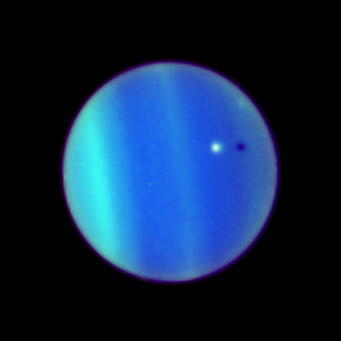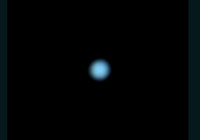
Last year, astronomers using the Hubble Space Telescope recorded tiny Ariel and its shadow as they transited for the first time since 1965.
Sean Walker
Tonight may be the best opportunity for amateurs with big telescopes (12 inches and larger) and planetary imaging setups to record the shadows of the largest Uranian moons crossing the face of Uranus.
The largest moons of Uranus, like those of all the giant planets, orbit almost exactly in the planet’s equatorial plane. Its spin axis is almost perpendicular to its orbit, so Uranus has showed its north pole to the Sun and Earth for the past four decades. But now the planet is having its first equinox — and therefore the first transits of its moons and their shadows across its face — since the invention of modern imaging devices. The first result is shown at right.
But just because the Hubble Space Telescope did it first doesn’t mean amateurs can’t try too! The two largest moons of Uranus, Titania and Oberon, appear 0.11 arcsecond wide, and their shadows are effectively that size also. This is much too small for any amateur scope to resolve — but that doesn’t matter. Half-arcsecond resolution will do, as long as your images have a good enough signal-to-noise ratio to show the shadow even when it’s blurred out to that size and therefore very low-contrast.
If you want to convince others that your transit images are real, you’ll need to record a series that clearly shows the shadow blur moving across Uranus’s disk at the right rate and in the right direction.
The time scales of these events are similar to those of the familiar shadow transits of Jupiter’s moons. Our Uranian moon finder can help you plan ahead for this and future events.

Uranus, imaged at high power on August 28, 2007, with a 12.5-inch reflector using the stacked-video technique. Visually Uranus appears far less colorful: pale gray with only a hint of green-blue.
S&T: Sean Walker
Tonight the Uranian shadow play begins at 23:15 UT (7:15 p.m. EDT October 2nd) as the shadow of Titania begins crossing Uranus, followed 20 minutes later by Titania itself. The shadow reaches the planet’s central meridian around 1:05 UT on the 3rd (9:05 EDT on the 2nd).
But wait, it gets better: at 1:58 UT the shadow of Ariel starts crossing Uranus too, presenting a rare double-transit opportunity. At 3:08 UT Titania’s shadow departs, followed by Ariel’s at 4:35 UT.
I suggest using at least a 12-inch telescope; smaller apertures will not produce a sufficiently bright image of the tiny planet. Even bigger scopes will increase your chances of recording this rare event. You’ll need excellent atmospheric seeing conditions too.
We’d love to see any results. Send them to our online gallery.
 0
0









Comments
You must be logged in to post a comment.